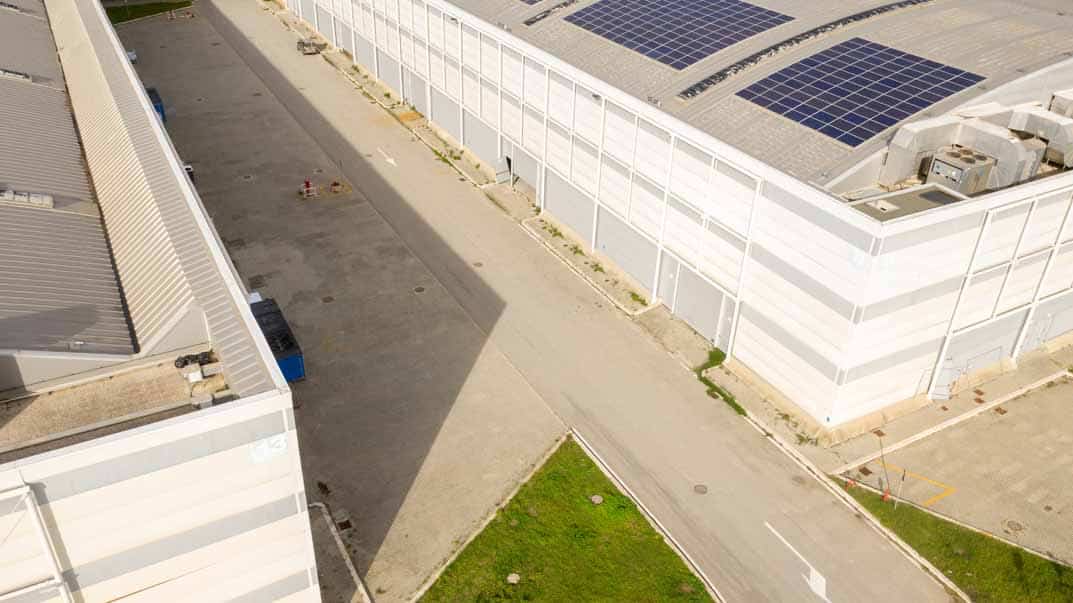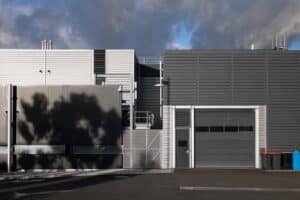Topics Covered:
If you run an equipment rental business, a construction fleet, or any other operation where gear and machinery have to cycle in and out quickly, you already know that waiting on a slow or unreliable garage door can cost you precious time—and money. A well-chosen and properly installed overhead door isn’t just about aesthetics; it’s about optimizing your entire workflow, boosting productivity, and ensuring your team can move gear in and out without unnecessary delays.
Why Every Second Counts in Equipment Turnaround
In fast-paced industries—from construction sites where bulldozers and cranes need quick in-and-out, to busy rental companies rotating gear multiple times a day—slowdowns at the garage door can pile up quickly. Every minute an operator waits for the door to open or close is a minute of lost productivity. Over a day, week, or year, these small delays can add up to significant labor costs and missed opportunities.
- Higher Throughput: The faster you can move equipment in and out, the more jobs you can tackle—or the more rentals you can process.
- Reduced Congestion: Quicker door cycles mean less vehicle backup and fewer bottlenecks in loading areas or driveways.
- Improved Employee Morale: Operating a door that’s smooth and quick makes everyone’s job easier, reducing frustration.
- Enhanced Customer Experience: If customers arrive to pick up or drop off equipment, minimal wait times improve your business’s reputation.
For businesses running multiple shifts or offering 24/7 access, these benefits are especially critical. A door that’s efficient and reliable can be a genuine competitive advantage.
High-Speed Door Operation: The Core of a Fast Workflow
When it comes to speeding up your processes, a high-speed door is often the first upgrade to consider. While a standard commercial door might open at 6-8 inches per second, high-speed doors can hit 24 inches per second or more—sometimes even faster. This substantial difference can literally save you minutes each time you roll in or out, which adds up fast in a busy environment.
- Reduced Wait Times: If you’re running a construction fleet of a dozen vehicles, a high-speed door might save each driver 30 seconds on entry and another 30 on exit, totaling a minute saved per vehicle. That’s 12 minutes saved per cycle in a single day!
- Better Climate Control: Doors that open and close quickly minimize the time the interior is exposed to outdoor temps, preserving conditioned or heated air.
- Lower Energy Costs: By reducing how long the door stays open, you also cut down on energy loss—a bonus if your facility is temperature-controlled.
Keep in mind, high-speed doors aren’t just about a powerful motor; they also need robust rollers, tracks, and possibly reinforced panels to handle the stress of frequent, rapid cycling.
Automation and Smart Controls
Manually operating a door might not seem like a big deal until you multiply that inconvenience by dozens of ins and outs per day. Automation—especially with smart features—eliminates wasted motion and time spent walking back and forth to operate the door.
- Remote Control or Key Fob: Operators can open the door from their vehicle, saving the step of dismounting to hit a button or pull a chain.
- Motion Sensors or Ground Loops: The door can automatically detect an approaching vehicle and initiate opening, further reducing downtime.
- Smartphone Integration: Some modern systems allow you to monitor and control doors via app—great for business owners or managers on the go.
- Auto-Close Timers: If no motion is detected for a set period, the door closes automatically, ensuring security and maintaining indoor conditions without relying on busy staff to remember.
By eliminating manual steps, automation ensures that the door is always open at the right moment, closes when not in use, and—perhaps most importantly—stays closed so your facility remains secure and climate-controlled between operations.
Durability and Maintenance: Minimizing Unplanned Downtime
A door that’s constantly breaking down will do the opposite of speeding up your workflow. While standard commercial doors can fail under the stress of large machinery or high-frequency operations, a door purpose-built for heavy use typically features high-cycle springs, heavier-gauge steel tracks, and reinforced panels.
- High-Cycle Springs: Standard torsion springs might handle 10,000 cycles, whereas high-cycle springs can handle 25,000–100,000+. Fewer spring replacements mean fewer operational hiccups.
- Robust Track Systems: Heavy-duty tracks resist bending or misalignment, crucial if you’re dealing with occasional bumps from forklifts or other equipment.
- Reinforced Door Panels: Panels that can withstand minor impacts or high wind loads keep the door operational longer, reducing the risk of costly repairs.
Don’t forget routine maintenance. A quick monthly or quarterly inspection can spot worn rollers, misaligned tracks, or fraying cables before they cause serious downtime. In high-use environments, scheduling professional tune-ups is a wise investment that pays off in reduced emergency service calls and extended door life.
Combining Safety Features with Speed
When equipment is constantly on the move, safety and speed must go hand in hand. Modern overhead doors come with built-in safety sensors—such as photo-eye beams or light curtains—that detect if a person or object is in the door’s path. This reduces the risk of collisions or injuries, and it’s critical in a busy facility where forklifts or vehicles might partially obstruct the opening.
- Photo-Eye Sensors: These stop or reverse the door if the beam is broken, preventing it from closing on equipment or personnel.
- Bottom Edge Sensors: Some doors have a pressure-sensitive edge that immediately reverses if contact is made.
- Soft Start/Stop: High-speed doors often use variable frequency drives to accelerate and decelerate smoothly, reducing wear on door components and lowering the risk of sudden impacts.
By integrating these safety features, you can confidently operate your doors at higher speeds without worrying about accidents or equipment damage.
Configuration and Layout: Enhancing Workflow Efficiency
Beyond door speed and durability, consider how layout and configuration can further optimize turnaround time:
- Multiple Doors: If you have the space, installing two or more doors—one for entry and one for exit—eliminates the bottleneck of waiting for a single door to clear multiple vehicles.
- Strategic Door Placement: Position doors close to loading/unloading zones or near workstations to shorten travel distances and reduce congestion.
- High-Wide Openings: Large door dimensions ensure that oversize equipment can pass without maneuvering or risk of scraping. This is especially helpful for unpredictable loads or attachments.
Sometimes small layout changes—like moving a door 10 feet closer to a loading dock or adding a dedicated exit door—can have a substantial impact on how quickly gear cycles in and out.
Climate Control Benefits
Equipment maintenance often requires a specific indoor environment—especially for delicate machinery or electronics. Installing an insulated garage door with a tight seal benefits more than just your energy bill:
- Faster Warm-Up/Cool-Down: If you’re bringing in cold or hot equipment from outside, a stable indoor temperature can speed up prep or repairs.
- Reduced Humidity Fluctuations: Sensitive machinery functions best in a steady humidity range, which is easier to maintain with an insulated, well-sealed door.
- Comfortable Work Environment: Techs or operators can do their jobs more efficiently in a workspace that’s protected from drafty air or extreme temps.
While you might initially focus on speed and durability for efficiency, factoring in insulation and weather sealing often pays off—both for worker productivity and equipment longevity.
ROI: Calculating Payback Over Time
Yes, a high-speed, high-cycle, or insulated door is a larger upfront expense than a basic commercial alternative. But the return on investment often becomes apparent relatively quickly:
- Productivity Gains: Shaving even 1–2 minutes per entry and exit can free up hours each week. That translates directly to labor cost savings or the ability to squeeze in extra tasks or rentals.
- Less Maintenance: Heavy-duty doors designed for frequent use break down less often, reducing repair bills and preventing unplanned downtime that stalls your entire operation.
- Energy Efficiency: Insulated, fast-closing doors curb climate control expenses, particularly in temperature-sensitive work areas.
- Longer Lifespan: Quality components often last years—or even decades—longer than budget doors, amortizing the cost over a much longer period.
Ultimately, the ROI equation often tips in favor of a robust, specialized door for businesses that rely on rapid equipment turnaround—especially as daily usage scales up.
Implementation Tips and Next Steps
If you’re ready to expedite your equipment workflow with a better overhead door setup, here are a few final pointers:
- Assess Your Traffic: Count how many equipment ins-and-outs occur daily. Use this data to determine needed door speed, size, and cycle rating.
- Engage Experts: Consult with a professional garage door company—like RJ Garage Door Services—to measure your space, suggest the right door type, and handle installation.
- Plan for Layout: If feasible, multiple doors or repositioning your existing door can drastically cut congestion. Don’t be afraid to reconfigure for efficiency.
- Budget for Quality: Resist the urge to go cheap. In a high-use environment, a quality door pays for itself via minimized downtime and labor savings.
- Maintenance Scheduling: Set up a clear plan for inspections, lubrication, and professional tune-ups. It’s easier to prevent problems than fix them mid-crisis.
By focusing on features like high-speed motors, automation, durable hardware, and proper maintenance, you’ll be well on your way to elevating your operation. At RJ Garage Door Services, we’ve seen firsthand how such upgrades can transform daily workflows. If you’re in the Raleigh, NC area—or beyond—and ready to revamp your facility’s door setup, give us a shout. We’re here to help evaluate your needs, recommend ideal solutions, and ensure a seamless installation that boosts efficiency today and for years to come.




